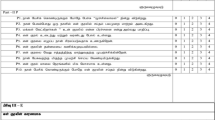Abstract
The voice handicap index (VHI) is one of the most widely used instruments for measuring a patient’s self-assessment of voice severity. In some ways, it reflects the patient’s quality of life. Although it has been recognized and widely applied to populations in European countries and to English speaking populations, it has not been used in its present forms in the Arabic speaking countries due to the specific language constraints of Euro-American terminology. The purposes of this study were to generate an Arabic version of VHI, to assess its reliability, and to apply it to a wide variety of normal and dysphonic individuals of Arabic descent. The Arabic version of VHI was derived in the standard way for test translation. The translated version was then administered to 65 patients with voice disorders and 65 control subjects. Participants’ responses were statistically analyzed to assess the validity, and to compare the pathological group with the control group. The Arabic VHI showed a significant high internal consistency and reliability (Cronbach’s α = 0.97 and r = 0.89, respectively), high item-domain and domain-total correlation (r = 0.73–0.94). There was a statistically significant difference between the control and the voice-disordered groups (P < 0.001). The results of this study demonstrated strong internal consistency of the Arabic VHI. Thus, the Arabic version of VHI is considered to be a valid and reliable self-assessment tool for the severity of voice disorders in Arabic language speaking patients.

Similar content being viewed by others
References
Woo P (1996) Quantification of videostrobolaryngoscopic findings—measurements of the normal glottal cycle. Laryngoscope 106:1–27
Benninger MS, Ahuja AS, Gardner G et al (1998) Assessing outcomes for dysphonic patients. J Voice 12:540–550
Jacobson BHJA, Grywalsky C et al (1997) The voice handicap index (VHI): development and validation. Am J Speech Lang Pathol 6:66–70
World Health Organization (1980) International Classification of impairments, disabilities and handicaps: a manual of classification relating to the consequences of disease. World Health Organization, Geneva, pp 25–43
Agency for Healthcare Research and Quality (2002) Criteria for determining disability in speech-language disorders. Evidence report/technology assessment
Nawka T, Wiesmann U, Gonnermann U (2003) Validation of the German version of the voice handicap index. HNO 51:921–930
Lam PK, Chan KM, Ho WK et al (2006) Cross-cultural adaptation and validation of the Chinese voice handicap index-10. Laryngoscope 116:1192–1198
Guimarães I, Abberton E (2004) An investigation of the voice handicap index with speakers of Portuguese: preliminary data. J Voice 18:71–82
Pruszewicz A, Obrebowski A, Wiskirska-Woznica B et al (2004) Complex voice assessment—Polish version of the voice handicap index (VHI). Otolaryngol Pol 58:547–549
Nunez-Batalla F, Corte-Santos P, Senaris-Gonzalez B et al (2007) Adaptation and validation to the Spanish of the voice handicap index (VHI-30) and its shortened version (VHI-10). Acta Otorrinolaringol Esp 58:386–392
Hakkesteegt MM, Wieringa MH, Gerritsma EJ et al (2006) Reproducibility of the Dutch version of the voice handicap index. Folia Phoniatr Logop 58:132–138
Amir O, Ashkenazi O, Leibovitzh T et al (2006) Applying the voice handicap index (VHI) to dysphonic and nondysphonic Hebrew speakers. J Voice 20:318–324
Helidoni ME, Murry T, Moschandreas J et al (2010) Cross-cultural adaptation and validation of the voice handicap index into Greek. J Voice 24(2):221–227
Hogikyan ND, Sethuraman G (1999) Validation of an instrument to measure voice-related quality of life (V-RQOL). J Voice 13:557–569
Gliklich RE, Glovsky RM, Montgomery WW (1999) Validation of a voice outcome survey for unilateral vocal cord paralysis. Otolaryngol Head Neck Surg 120:153–158
Deary IJ, Webb A, Mackenzie K et al (2004) Short, self-report voice symptom scales: psychometric characteristics of the voice handicap index-10 and the vocal performance questionnaire. Otolaryngol Head Neck Surg 131:232–235
Deary IJ, Wilson JA, Carding PN et al (2003) VoiSS: a patient-derived voice symptom scale. J Psychosom Res 54:483–489
Rosen CA, Lee AS, Osborne J et al (2004) Development and validation of the voice handicap index-10. Laryngoscope 114:1549–1556
Rosen CA, Murry T, Zinn A et al (2000) Voice handicap index change following treatment of voice disorders. J Voice 14:619–623
Hsiung MW, Pai L, Wang HW (2002) Correlation between voice handicap index and voice laboratory measurements in dysphonic patients. Eur Arch Otorhinolaryngol 259:97–99
Schindler A, Mozzanica F, Vedrody M et al (2009) Correlation between the voice handicap index and voice measurements in four groups of patients with dysphonia. Otolaryngol Head Neck Surg 141:762–769
Malki KH, Al-Habib SF, Hagr AA et al (2009) Acoustic analysis of normal Saudi adult voices. Saudi Med J 30:1081–1086
Nawka T, Verdonck-de Leeuw IM, De Bodt M et al (2009) Item reduction of the voice handicap index based on the original version and on European translations. Folia Phoniatr Logop 61:37–48
Kotby M (1995) The accent method of voice therapy. Singular Publishing Group, Inc., San Diego, pp 1–21
Amir O, Tavor Y, Leibovitzh T et al (2006) Evaluating the validity of the voice handicap index-10 (VHI-10) among Hebrew speakers. Otolaryngol Head Neck Surg 135:603–607
Hsiung MW, Lu P, Kang BH et al (2003) Measurement and validation of the voice handicap index in voice-disordered patients in Taiwan. J Laryngol Otol 117:478–481
Acknowledgments
This study was funded by the Research Center of Medical College, King Saud University, Riyadh, Saudi Arabia. It was supervised by the Research Chair of Voice and Swallowing Disorders (RCVASD), King Saud University.
Author information
Authors and Affiliations
Corresponding author
Appendices
Appendix 1

Appendix 2

Rights and permissions
About this article
Cite this article
Malki, K.H., Mesallam, T.A., Farahat, M. et al. Validation and cultural modification of Arabic voice handicap index. Eur Arch Otorhinolaryngol 267, 1743–1751 (2010). https://doi.org/10.1007/s00405-010-1296-x
Received:
Accepted:
Published:
Issue Date:
DOI: https://doi.org/10.1007/s00405-010-1296-x




